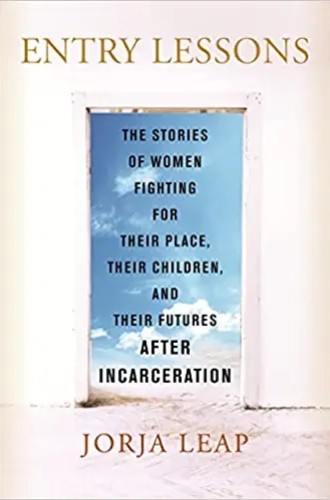Women after incarceration
Anthropologist Jorja Leap bears witness to the struggles of women reentering society through programs designed for men.
Being released from prison comes with myriad struggles: negotiating logistical and bureaucratic obstacles seemingly designed to encourage recidivism; coping with new (and old) mental, emotional, and physical traumas; trying to repair and establish healthy relationships; and, in many cases, being thrust back into the same physical environment, with the same triggers and struggles, that led to incarceration in the first place.
Anthropologist Jorja Leap sees this struggle. Having previously researched how men become involved in gangs, she turned her attention to women involved in gangs, this time with an additional emphasis on what these women’s lives are like after incarceration. Entry Lessons is the result of Leap’s research into two main questions: What are the differences between men’s and women’s experiences with gangs, incarceration, and reentry, and how can reentry programs and services address those gendered differences in order to best serve formerly incarcerated women?
Read our latest issue or browse back issues.
Women experience gangs differently than men do, Leap explains. They take on supporting roles, such as “girlfriends, or hood rats, or baby mamas” and “accomplices, personal assistants.” Most women are drawn to gangs for protection, in many cases because they experienced trauma as children. But not everyone understands protection in the same way. Leap points out that young girls are arrested “for their protection” more than young boys are, as authorities suppose that girls will be safer locked up than on the streets.
Women in prison often have to deal with issues that their male counterparts don’t, especially when it comes to parenting. Eighty percent of incarcerated women are mothers. Many of them grew up in the child welfare system and are terrified of their kids growing up there as well. Incarcerated men typically have someone on the outside—their wife or girlfriend or child’s mother, or their own mother—to take care of their kids. Children of incarcerated mothers are five times as likely to end up in foster care as children of incarcerated fathers.
As she talks to incarcerated women, Leap makes a startling observation. She knew of women who regularly took four-hour bus rides to visit their incarcerated boyfriends or husbands. Yet, she notes,
when I put together all the material on the women I’d interviewed, laughed with, spent time with—all eighty of them—not a single woman told me she was visited by a spouse, partner, or boyfriend while locked up. There were also no accounts of men who brought children to visit their mothers. Instead, these women saw their children when grandmothers or other family members or social workers brought them to visit.
This lack of support during incarceration is devastating for women. And it is mirrored after release: Leap finds that reentry programs are designed for men and do not adequately address women’s unique needs.
When women leave prison, they generally need some combination of health care, mental health treatment, social services, vocational training, education, and a job that offers financial security. But women who are mothers must also worry about their children’s needs. Can they find a place to live with their children? How can they repair their relationships with children they haven’t seen in years? Will their kids be taken care of while they focus on their own traumas and all the bureaucratic hoops they need to jump through?
Most reentry programs aren’t prepared to meet those needs. Halfway houses are “just another form of incarceration,” Leap writes. Filled with zero tolerance policies, strict benchmarks that must be met, and high financial costs, they dole out punishment instead of healing. They rarely offer trauma-informed care.
This last point shows a failure to address what Leap argues is the biggest struggle of release: relapse. Among Leap’s interviewees, “crime was secondary to all of the related problems that drove women to substance abuse.” But during reentry, women are offered substance abuse programs that “stay away from uncovering trauma. The rationale being that individuals need to be sober and in recovery first. In turn, mental health programs don’t want to treat women who are dealing with substance abuse issues.” Women are caught in a catch-22: their substance abuse programs won’t address the trauma that is the underlying cause, and mental health programs won’t take them on until they’re sober.
Leap helpfully profiles a few reentry programs that are designed specifically for incarcerated women. One is A New Way of Life Reentry Project, a Los Angeles–based nonprofit that emphasizes healing and community, with no benchmarks or limits on how long women can use their services. ANWOL offers mental health and substance abuse treatment and addresses relapses on a case-by-case basis. For the first 30 days in the program, women have no outside visits unless for a specific reason, which allows them to focus on their reentry with no distractions. ANWOL boasts a success rate of 96 percent—only 4 percent of its women recidivate.
Also in Los Angeles is Homegirl Café, a part of Homeboy Industries, which was founded by Catholic priest Greg Boyle to help former gang members. Homegirl Café, a common setting throughout Entry Lessons, gives women who were associated with gangs a place to work and to help each other heal from trauma. Like ANWOL, it embodies the belief that one of the best reentry tools is formerly incarcerated women who understand each other in a way others can’t.
In New York, Hour Children aims, in the group’s own words, “to help incarcerated and formerly incarcerated women and their children successfully rejoin the community, reunify with their families, and build healthy, independent and secure lives.” It provides reentering women with parenting lessons and consistent visits with their children. Hour Children also created a program that allows incarcerated mothers to live with their babies for the first 18 months of the child’s life. These moms work or attend classes during the day while employees care for their children in a nursery inside the correctional facility.
Sadly, A New Way of Life, Homegirl Café, and Hour Children are one-off programs with limited reach. There is no systemic nationwide response to the needs of incarcerated and formerly incarcerated women. There are no recognized best practices. The few successful and restorative women’s reentry programs are on their own, and their stories—and the stories of the individuals they help—remain largely untold.
Running throughout Entry Lessons is the implicit theme of bearing witness. In one of the first chapters, Leap describes a fundraising tour she led through a women’s prison. The incarcerated women who talked with the guests “kept talking to anyone who will listen” about their homesickness, their hunger, their need for sanitary products, their children, and many other topics. Near the end of the book, Leap offers a parallel reflection on a text message conversation she has with a formerly incarcerated woman named Denise, who is now her student. “I don’t want to text that I understand—there’s no way I truly understand,” Leap writes. “Still, I want to bear witness to her struggle and make sure her words are heard.”
Incarcerated women need to be able to tell their stories, and non-incarcerated people need to bear witness to them. Entry Lessons is Leap’s act of bearing witness: to Denise, to the 80 women Leap interviewed, and to the countless others whose stories are reflected in the book.







